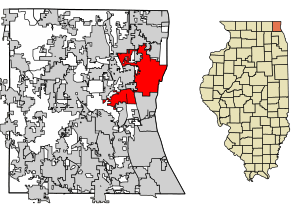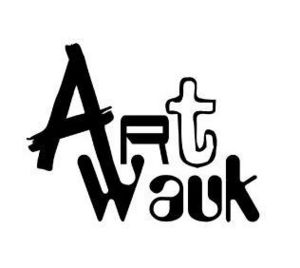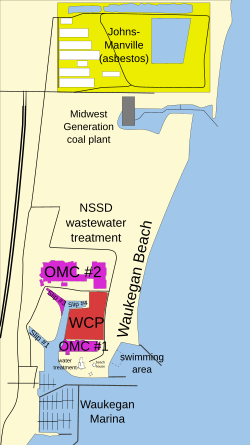Waukegan, Illinois facts for kids
Quick facts for kids
Waukegan, Illinois
|
|
|---|---|
| City of Waukegan | |
| Nickname(s):
The Town, The ‘Kegan, Green Town, Talk Town, WaukTown
|
|
| Motto(s):
An Illinois Arts-Friendly Community
|
|

Location of Waukegan in Lake County, Illinois.
|
|
| Country | United States |
| State | Illinois |
| Counties | Lake |
| Founded | 1829 |
| Incorporated (town) | March 31, 1849 |
| Incorporated (city) | February 23, 1859 |
| Named for | Potawatomi: Wakaigin (Fortress or Trading Post) |
| Government | |
| • Type | Mayor–council |
| Area | |
| • City | 24.47 sq mi (63.38 km2) |
| • Land | 24.22 sq mi (62.72 km2) |
| • Water | 0.26 sq mi (0.66 km2) 0.99% |
| Elevation | 715 ft (218 m) |
| Population
(2020)
|
|
| • City | 89,321 |
| • Rank | 10th largest in Illinois 390th largest in U.S. |
| • Density | 3,688.36/sq mi (1,424.06/km2) |
| • Metro | 9,472,676 |
| Demonym(s) | Waukeganite |
| Time zone | UTC−6 (CST) |
| • Summer (DST) | UTC−5 (CDT) |
| ZIP Codes |
60079, 60085, 60087
|
| Area code(s) | 847 & 224 |
| FIPS code | 17-79293 |
| U.S. Routes | |
| Major State Routes | |
| Waterways | Waukegan River |
| Airports | Waukegan National Airport |
Waukegan, is the most populous city in, and the county seat of Lake County, Illinois, United States. An industrial suburb of Chicago, the city is situated approximately 26 miles (42 km) north of Chicago’s North Side, along the shores of Lake Michigan. As of the 2020 census, the population of the city was 89,321, ranking it the seventh most populous city within the Chicago metropolitan area, the tenth most populous city in Illinois, and the 390th most populous city in the country. Waukegan has a significant working-class population, as well as some poor areas within the city. Additionally, there is also a moderately sized middle-class community that exists within the city.
Contents
History
The site of present-day Waukegan was recorded as Riviere du Vieux Fort ("Old Fort River") and Wakaygagh on a 1778 map by Thomas Hutchins. By the 1820s, the French name had become "Small Fort River" in English, and the settlement was known as "Little Fort". The name "Waukegance" and then "Waukegan" (meaning "little fort"; cf. Potawatomi wakaigin "little fort") was created by John H. Kinzie and Solomon Juneau, and the new name was adopted in 1849.
Waukegan had an abolitionist community dating to these early days. In 1853, residents commemorated the anniversary of emancipation of slaves in the British Empire with a meeting. Waukegan arguably has the distinction of being the only place where Abraham Lincoln failed to finish a speech; when he campaigned in the town in 1860, a fire alarm rang, and the man soon-to-be president had his words interrupted.
Waukegan's development began in many ways with the arrival of Washburn & Moen, a barbed-wire manufacturer that prompted both labor migration and land speculation beginning in 1891. Immigrants followed, mostly hailing from southeastern Europe and Scandinavia, with especially large groups from Sweden, Finland, and Lithuania. The town also became home to a considerable Armenian population. One member of this community, Monoog Curezhin, even became embroiled in an aborted plot to assassinate Sultan Abdul Hamid II, reviled for his involvement in massacres of Armenians in the Ottoman Empire. Curezhin lost two fingers on his right hand while testing explosives for this purpose in Waukegan in 1904.
By the 1920s and 1930s, African-Americans began to migrate to the city, mostly from the south.
The city retained a distinct industrial character in contrast to many of the residential suburbs along Chicago's North Shore. The unequal distribution of wealth created by the disappearance of manufacturing from the city in part contributed to the Waukegan Riot of 1966. Central to this event and the remainder of Waukegan's 20th century history was Robert Sabonjian, who served as mayor for 24 years, and earned the nickname the "Mayor Daley of Waukegan" for his personal and sometimes controversial style of politics.
Geography
Waukegan is located at 42°22′13″N 87°52′16″W / 42.37028°N 87.87111°W (42.3703140, -87.8711404). Waukegan is on the shore of Lake Michigan, about 8 miles (13 km) south of the border with Wisconsin and 40 miles (64 km) north of downtown Chicago, at an elevation of about 715 feet (218 m) above sea level.
According to the 2010 census, Waukegan has a total area of 23.879 square miles (61.85 km2), of which 23.67 square miles (61.31 km2) (or 99.12%) is land and 0.209 square miles (0.54 km2) (or 0.88%) is water.
Demographics
| Historical population | |||
|---|---|---|---|
| Census | Pop. | %± | |
| 1860 | 3,433 | — | |
| 1870 | 4,507 | 31.3% | |
| 1880 | 4,012 | −11.0% | |
| 1890 | 4,915 | 22.5% | |
| 1900 | 9,426 | 91.8% | |
| 1910 | 16,069 | 70.5% | |
| 1920 | 19,226 | 19.6% | |
| 1930 | 33,499 | 74.2% | |
| 1940 | 34,241 | 2.2% | |
| 1950 | 46,698 | 36.4% | |
| 1960 | 61,784 | 32.3% | |
| 1970 | 65,134 | 5.4% | |
| 1980 | 67,653 | 3.9% | |
| 1990 | 69,392 | 2.6% | |
| 2000 | 89,426 | 28.9% | |
| 2010 | 89,078 | −0.4% | |
| 2020 | 89,321 | 0.3% | |
| U.S. Decennial Census 2010 2020 | |||
2020 census
| Race / Ethnicity | Pop 2010 | Pop 2020 | % 2010 | % 2020 |
|---|---|---|---|---|
| White alone (NH) | 19,370 | 14,003 | 21.74% | 15.68% |
| Black or African American alone (NH) | 16,240 | 14,647 | 18.23% | 16.40% |
| Native American or Alaska Native alone (NH) | 173 | 129 | 0.19% | 0.14% |
| Asian alone (NH) | 3,722 | 4,576 | 4.18% | 5.12% |
| Pacific Islander alone (NH) | 26 | 35 | 0.03% | 0.04% |
| Some Other Race alone (NH) | 577 | 817 | 0.65% | 0.91% |
| Mixed Race/Multi-Racial (NH) | 1,358 | 2,011 | 1.52% | 2.25% |
| Hispanic or Latino (any race) | 47,612 | 53,103 | 53.45% | 59.45% |
| Total | 89,078 | 89,321 | 100.00% | 100.00% |
Note: the US Census treats Hispanic/Latino as an ethnic category. This table excludes Latinos from the racial categories and assigns them to a separate category. Hispanics/Latinos can be of any race.
2019 United States Census Bureau American Community Survey estimates
|
Racial Makeup of Waukegan (2019) White alone (51.00%) Black alone (17.39%) Native American alone (0.58%) Asian alone (5.21%) Pacific Islander alone (0.03%) Some other race (21.89%) Two or more races (3.90%) |
Racial Makeup of Waukegan treating Hispanics as a Racial Category (2019) |
Racial Makeup of Hispanics in Waukegan (2019) White alone (57.13%) Black alone (0.43%) Native American alone (0.47%) Asian alone (0.32%) Pacific Islander alone (0.04%) Other race alone (38.31%) Two or more races (3.30%) |
As of the 2010 United States Census, there were 89,078 people living in the city. The racial makeup of the town was 46.6% White (21.7% non-Hispanic White), 19.2% African-American, 4.3% Asian, 1.2% Native American, 0.1% Pacific Islander, 24.6% some other race, and 4.1% of two or more races. 53.4% were Hispanic or Latino (of any race). Majority of residents of Latin American descent in Waukegan are of Mexican descent, Waukegan also has one of the highest Honduran population in Illinois, as well as many Puerto Rican, Cuban, and Central American descendants. 5.3% of Waukegans non-Hispanic white population were of German ancestry.
As of the census of 2000, there were 87,901 people, 27,787 households, and 19,450 families living in the city. The population density was 1,475.0/km2 (3,762.8/mi2). There were 29,243 housing units at an average density of 490.7/km2 (1,270.8/mi2). The racial makeup of the city was 30.92% White, 19.21% African American, 0.54% Native American, 3.58% Asian, 0.06% Pacific Islander, 22.96% from other races, and 3.50% from two or more races. Hispanic or Latino of any race were 44.82% of the population.
There were 27,787 households, out of which 40.4% had children under the age of 18 living with them, 49.5% were married couples living together, 14.6% had a female householder with no husband present, and 30.0% were non-families. 24.2% of all households were made up of individuals, and 7.5% had someone living alone who was 65 years of age or older. The average household size was 3.09 and the average family size was 3.68.
In the city, the population was spread out, with 30.2% under the age of 18, 12.1% from 18 to 24, 33.4% from 25 to 44, 16.4% from 45 to 64, and 7.9% who were 65 years of age or older. The median age was 29 years. For every 100 females, there were 103.1 males. For every 100 females age 18 and over, there were 103.2 males.
The median income for a household in the city was $42,335, and the median income for a family was $47,341. Males had a median income of $30,556 versus $25,632 for females. The per capita income for the city was $17,368. About 24% of families and 24.7% of the population were below the poverty line.
Religion
Of the 54.4% of the population that identify as religious, the most populous group is Catholic, at 31.0%. Additional percentages are 3.2% Lutheran, 1.9% Baptist, 1.6% Presbyterian, 1.5% Methodist, and approximately 11% other Christian denominations. Other faiths include 2.7% Jewish, and 1.4% Islamic.
Christ Episcopal Church on the corner of Grand Avenue and West Street is a historic church, one of the first ones in Waukegan.
The Roman Catholic Archdiocese of Chicago operates Catholic churches. On July 1, 2020, St. Anastasia Parish and St. Dismas Parish will merge, with the former having the parish school and the latter having the parish church.
Revitalization
The city has plans for redevelopment of the lakefront. The lakefront and harbor plan calls for most industrial activity to be removed, except for the Midwest Generation power plant and North Shore wastewater treatment facilities. The existing industry would be replaced by residential and recreational space. The city also set up several tax increment financing zones which have been successful in attracting new developers. The first step in the revitalization effort, the opening of the Genesee Theatre, has been completed, many new restaurants have opened, buildings have been renovated, and the City of Waukegan has made substantial investments in the pedestrian areas and other infrastructure.
The city had an annual "Scoop the Loop" summer festival of cruising since 1998, which since 2010 became a monthly event during the summer. The current incarnation is known as "Scoop Unplugged".
Tourism
Popular events
- ArtWauk
ArtWauk (ArtWalk) is an art event that happens every third Saturday of the month in Downtown Waukegan. ArtWauk features paintings, sculptures, films, dance, theatre, comedy, music, performance art, food, pedicabs, all in the Waukegan Arts District in Downtown Waukegan.
- Chicago Latino Film Festival
- Fiestas Patrias Parade and Festival
The Fiestas Patrias Parade and Festival in Downtown Waukegan highlights and celebrates the independence of the many Hispanic countries that are represented in Waukegan, including Mexico, Belize, Honduras, etc.
- HolidayWAUK
HolidayWAUK (HolidayWalk) is Downtown Waukegan's holiday festival.
Popular tourist destinations
- Downtown Waukegan
- Downtown Waukegan is the urban center of Lake County. Many restaurants, bars, shops, the Waukegan Public Library, the College of Lake County, the Lake County Courthouse (including the William D. Block Memorial Law Library), and much more call Downtown Waukegan their home.
- Genesee Theatre
- Lake County Sports Center
- Waukegan History Museum
- Ray Bradbury sites
Superfund sites
Waukegan contains three Superfund sites of hazardous substances that are on the National Priorities List.
In 1975, PCBs were discovered in Waukegan Harbor sediments. Investigation revealed that during manufacturing activities at Outboard Marine Corporation (OMC), hydraulic fluids containing PCBs had been discharged through floor drains at the OMC plant, directly to Waukegan Harbor and into ditches discharging into Lake Michigan. The OMC plants were subsequently added to the National Priorities List, and was designated as one of 43 Great Lakes Areas of Concern. Cleanup of the site began in 1990, with OMC providing $20–25 million in funding. During the OMC cleanup, additional soil contaminants were found at the location of the former Waukegan Manufactured Gas and Coke company. Soil removal was completed at the Coke site in 2005, and cleanup of that soil will continue for several years.
The Johns Manville site is located one mile (1.6 km) north of the OMC site. In 1988, asbestos contamination found in groundwater and air prompted listing on the National Priorities List and subsequent cleanup. In 1991, the soil cover of the asbestos was completed. However, additional asbestos contamination was found outside the Johns-Manville property which will require further cleanup.
The Yeoman Creek Landfill is a Superfund site located 1.5 miles (2.4 km) west of the Johns Manville site. The site operated as a landfill from 1959 to 1969. In 1970, it was discovered that the lack of a bottom liner in the landfill had allowed leachate to enter groundwater, contaminating the water with volatile organic compounds and PCBs, and releasing gases that presented an explosion hazard. All major cleanup construction activities were completed in 2005, and monitoring of local water and air continues.
The book Lake Effect by Nancy Nichols gives an account of the effects of PCBs on Waukegan residents.
Historical sites
- Bowen Park
- Naval Station Great Lakes
- Waukegan Building
- Waukegan Public Library
Twin towns and sister cities
Waukegan has one sister city:
Although there is no official sister city relationship, Waukegan is home to approximately 6,000 people from Tonatico, Mexico, according to a February 2017 article in the Washington Post. This has created ongoing ties between the two cities.
Economy
Top employers
According to Waukegan's 2019 Comprehensive Annual Financial Report, the top employers in the city were:
| # | Employer | # of Employees |
|---|---|---|
| 1 | Lake County | 1,718 |
| 2 | Southwire Co. | 1,500 |
| 3 | Medline Industries Inc. | 850 |
| 4 | Vista Medical East Center | 838 |
| 5 | Lake Behavioral Hospital | 800 |
| 6 | Jewel-Osco | 515 |
| 7 | Waukegan Community Unit School District 60 | 500 |
| 8 | Bel Resources | 450 |
| 9 | Kiley Developmental Center | 423 |
| 10 | Yaskawa America, Inc. | 400 |
Revitalization
The city has plans for redevelopment of the lakefront. The lakefront and harbor plan calls for most industrial activity to be removed, except for the Midwest Generation power plant and North Shore wastewater treatment facilities. The existing industry would be replaced by residential and recreational space. The city also set up several tax increment financing zones which have been successful in attracting new developers. The first step in the revitalization effort, the opening of the Genesee Theatre, has been completed, many new restaurants have opened, buildings have been renovated, and the City of Waukegan has made substantial investments in the pedestrian areas and other infrastructure.
The city has had an annual "Scoop the Loop" summer festival of cruising since 1998, which since 2010 has become a monthly event during the summer. The current incarnation is known as "Scoop Unplugged".
Education
Waukegan is served by the Waukegan Public School District 60. It serves about 17,000 students in preschool through grade twelve. Waukegan has three early childhood schools, fifteen elementary schools, five middle schools, and three high school campuses.
The multi-campus Waukegan High School serves high school students. From 1999 to 2009, the current Washington campus served as the Ninth Grade Center, while Brookside Campus served students in grades 10–12. Since then, both campus have served students in grades 9–12, who are split into numbered houses.
Cristo Rey St. Martin College Prep, a private Catholic high school, is in Waukegan.
Immanuel Lutheran School is a Pre-K-8 grade school of the Wisconsin Evangelical Lutheran Synod in Waukegan.
Notable people
Jack Benny
Waukegan is the hometown of comedian Jack Benny (1894–1974), one of the 20th century's most notable and enduring entertainers, but although he claimed for decades on his radio and television shows to have been born there, he was actually born at Mercy Hospital in Chicago. Benny's affection for the town in which he grew up can clearly be felt by this exchange with his co-star (and wife) Mary Livingstone during a conversation they had on The Jack Benny Program on Mother's Day of 1950 while they were discussing the itinerary for his summer tour that year:
- Mary Livingstone: Aren't you going to bring your show to Waukegan?
- Jack Benny: Mary, I was born in Waukegan — how can you follow that?!.
On a 1959 episode of the television game show What's My Line?, Benny quipped to host John Charles Daly
They say that I put Waukegan on the map. But it's not true. Waukegan really put me on the map. That's a fact.
Nevertheless, Benny did put Waukegan on the map for millions of his listeners (and later viewers) over the years, and the community was proud of his success. A Waukegan middle school is named in his honor (which he said was the greatest thrill he had ever experienced), and a statue of him, dedicated in 2002, stands in the downtown facing the Genesee Theater, which hosted the world premiere of his film Man about Town in 1939, with Jack, Mary, Dorothy Lamour, Phil Harris, Andy Devine, Don Wilson and Rochester (Eddie Anderson) appearing onstage.
Jack Benny's family lived in several buildings in Waukegan during the time he was growing up there, but the house at 518 Clayton Street is the only one of them that still stands. It was designated a landmark by the city on April 17, 2006.
Ray Bradbury
The science-fiction author and novelist Ray Bradbury (1920–2012), was born in Waukegan, and though he moved with his family to the West Coast while still a child, many of his stories explicitly build on Waukegan (often called Green Town in his stories, such as Dandelion Wine) and his formative years there. Ray Bradbury Park, located at 99 N. Park Ave. in Waukegan, is named after him.
Otto Graham
Pro Football Hall of Fame quarterback Otto Graham (1921–2003) was born and raised in Waukegan and attended nearby Northwestern University on a basketball scholarship, though football soon became his main sport. Graham played quarterback for the Cleveland Browns in the All-America Football Conference (AAFC) and National Football League (NFL), taking his team to league championships every year between 1946 and 1955, winning seven of them. While most of Graham's statistical records have been surpassed in the modern era, he still holds the NFL record for career average yards gained per pass attempt, with 8.98. He also holds the record for the highest career winning percentage for an NFL starting quarterback, at 0.814. Graham is one of only two people (the other being Gene Conley) to win championships in two of the four major North American sports—1946 NBL (became NBA) and AAFC championship, plus three more AAFC and three NFL championships.
Images for kids
See also
 In Spanish: Waukegan para niños
In Spanish: Waukegan para niños






